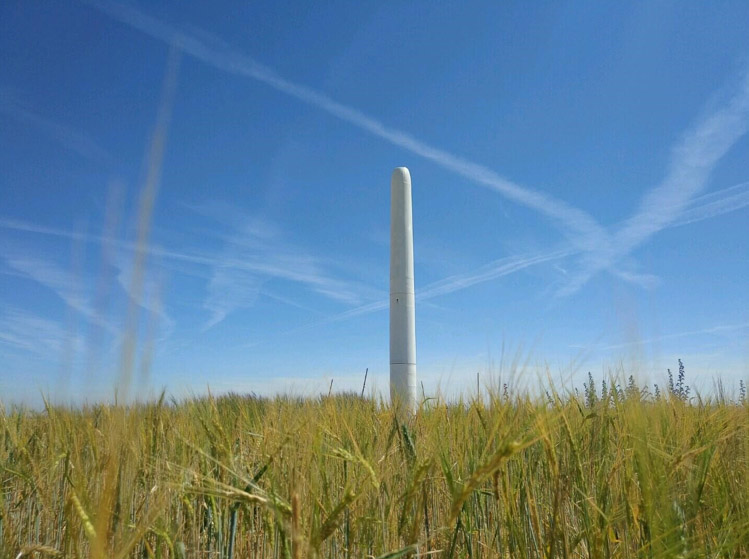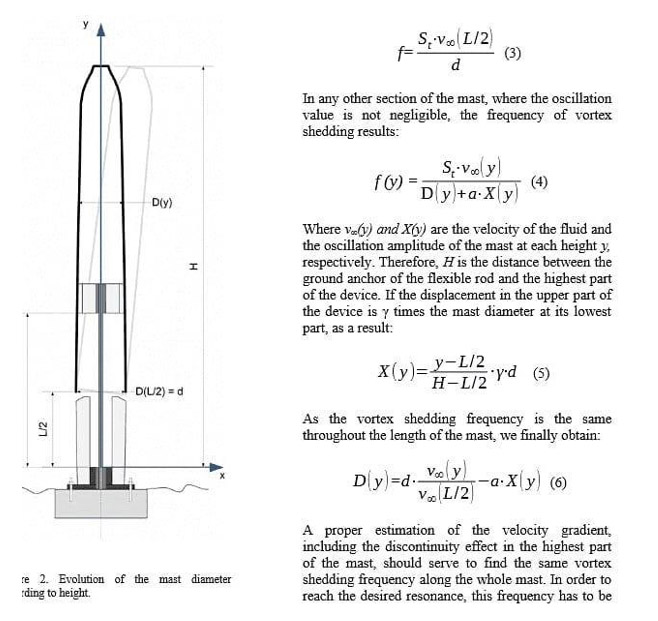|
|

|
  
Features
Update 2021/4/13
Renewable Energy
brought to you in part by

BLADELESS WIND ENERGY: HARVESTING WIND’S KINETIC ENERGY TO GENERATE ELECTRICITY
A small Research and Development (R&D) tech start-up based in Madrid and Avila, Spain has designed the world’s first bladeless, gearless, oil-less wind turbine that is harmless to birds. The self-running turbine conceptualized by Vortex Bladeless (youtu.be) is being developed for in-site wind generation as a low maintenance stand-alone, that quickly adapts to wind changes.

Vortex wind generators (designed to be an equivalent of solar energy in features) are expected to have lower cost, carbon footprint and usage of materials than regular wind turbines. Photo courtesy Vortex Bladeless
WATERTODAY had the pleasure of interviewing Jorge Pinero about the idea behind the start-up's journey.
“David Yanez had the original idea in 2012 when he was a university student seeing the famous video of the collapse of Tacoma Narrows Bridge (Galloping Gertie)(youtu.be). The idea sat in a drawer until the time was right,” Pinero told WT.
In 2015 Vortex Bladeless was born when a small group of technical experts – including an aerospace engineer and an expert in fluid dynamics—took on the task of understanding the physics of the vortex effect and product design. (youtu.be)
The fundamentals of the vortex induced resonant wind generator idea is based on harnessing wind energy from a phenomenon called Vortex Shedding.

“Roughly speaking, the Vortex Shedding or Vortex Street effect is produced when a fluid passes around a circular slender structure, then 3D vortex turbulences are created behind and around on a specific frequency. Vortex Induced Vibrations are an aeroelasticity phenomenon where structures couple in sync with these vortexes and there is a transmittance of energy,” Pinero explains.

“These concepts among others are not fully understood in current physics and the knowledge is mainly toward avoidance as it can make planes or buildings collapse. You can see this very phenomenon on random things in daily life when its windy, like on light poles, and flags for instance.
“With our investigations we seek to enhance this phenomenon, to control it and to harness the higher amount of energy possible from it.”

Vortex Bladeless devices are very simple mechanically. They consist in a circular slender mast that moves freely with the wind and a fixed base. These two are attached by a carbon fiber rod that flexes. Inside there is an alternator and a turning system for it to keep in sync with a wide
range of vortexes frequencies. When the natural oscillation frequency of the device and the vortexes are close, the device starts to harness energy from them. Then the movement is converted to electricity by the alternator (a different one from the one in your car but the same
concept) Photo Courtesy Vortex Bladeless
“The geometry of the mast as well as the turning system allows it to be in sync with the vortexes and control their alignment, so its energy can be harnessed. Interestingly the math behind our geometry is inspired in the math behind bird wings and fish tails, as the very same vortexes are created when these animals move.” How it works: (youtu.be)
One of the advantages of the Vortex Bladeless systems is sound – or lack of it.
“Physically speaking you cannot say there is no noise, as any dynamic system in movement will leak energy in the form of heat and noise. The point here is how much energy is leaked and on what frequency,” Pinero says.
“Generally, you won’t hear anything coming from our devices. Any possible energy leaking in form of noise is negligible (under 10hz). Also, the devices only move when it is windy, so it would only be the sound of the wind that is audible.” The ultra-low frequencies are also not significant enough for wildlife.
A huge concern with wind turbines is the devastation to wildlife as the best spots for wind power are also where migrating birds pass by. Both rely on wind currents, and the turbines tend to drag flying animals into collision with the blades. Also, the echolocation system of bats gets confused with the fast spin and they fly right into the turbines.
“With Vortex devices there is no problem with animals flying nearby as our movement is somehow similar to a slender tree oscillating in the wind. Animals are very experienced in avoiding these and they can predict the oscillations better than the spin of a blade.”
As for climate change mitigation Pinero adds that since the company is still under development. However, studies are pointing toward a better carbon footprint and levelized cost of energy figures than regular wind power.
“This is mainly due to small reasons like differences in production, the lack of oiling and maintenance. But as these calculations involve the whole life cycle of a device, from raw material to wasteland, we cannot calculate real numbers until we have a few installations working for its whole life cycle.”
Although many prototype installations have happened in Avila, Spain and the small surrounding towns, Pinero adds that Vortex Bladeless is in its 8th year of a 10-15 yearlong R&D project.
“By now we have reached the beta stage for the smallest devices we have. The Vortex Nano (85 cm high and 8 cm in diameter) are being installed on universities and research centers around the world to accumulate data and insight.
“For the larger models, the development is in a younger state and engineering is tricky to scale up. Commercialization could still take years while waiting for all the certifications.”
Compared to regular wind power, ecologists and naturalists tend to value the bladeless technology, not only because it can be harmless to wildlife, but also because of the lower visual impact which modifies the land radically.
“We are not here to compete or replace with regular wind power. We are developing a different technology to current ones so consumers can choose between a wider range of options to become greener and help the energy transition the world needs.”
suzanne.f@watertoday.ca
|
|
|
Have a question? Give us a call 613-501-0175
All rights reserved 2025 - WATERTODAY - This material may not be reproduced in whole or in part and may not be distributed,
publicly performed, proxy cached or otherwise used, except with express permission.
|
| |